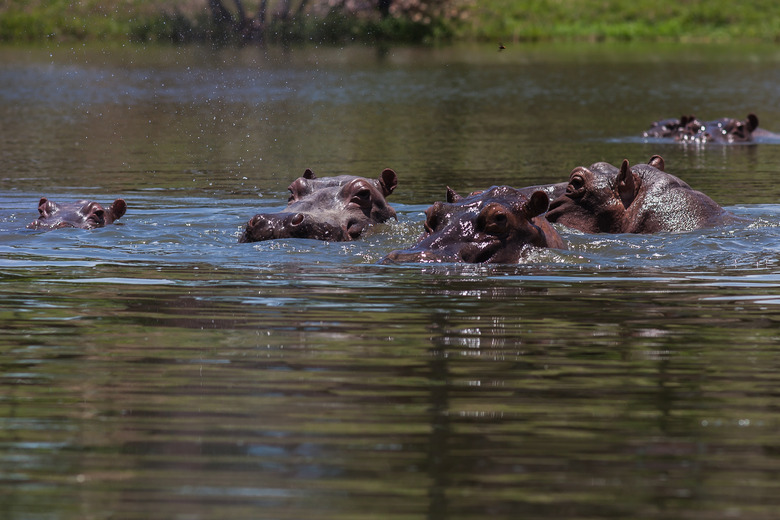Pablo Escobar's Hippos Are Taking Over Colombia
Colombia's got a hippo problem.
It's not a problem Colombia is supposed to have. The country is home to many incredible species – the beasts are native to several African countries, but aren't found in South America.
That is, they weren't, until Pablo Escobar decided he wanted some for his menagerie. For his giant estate that also included attractions like a bull ring and a go-kart race track, the legendary drug lord smuggled animals across borders and oceans to build his own zoo. When he died, many of the animals like giraffes and elephants got sent to actual, official zoos.
But the four hippos stuck around. And then they multiplied. And now, researchers think there's as many as 100 hippos lazing around a Colombian river. They're calling them an invasive species, and they aren't really sure what they're going to do about it.
What’s an Invasive Species?
What's an Invasive Species?
At its most simple, an invasive species is just a species that's been introduced somewhere it doesn't belong, and can cause damage to the local ecosystem. Sometimes, invasive species travel naturally around the globe. Zebra mussels, for instance, probably hitched a ride from Europe to North America by latching onto ships. Now, they've taken over the Great Lakes region, and wreak havoc like snagging all the food that the native species need and clogging water treatment and power plants.
Others have actually been introduced to new environments purposely, like cane toads. The toads were native to areas like Hawaii and the Philippines, and were helpful in those areas because they ate the beetles that were ravaging sugarcane supplies. Australia wanted their beetles eaten, too, so in the 1930s, they released tens of thousands of cane toads as pest management.
It didn't go so hot. Partly because of a difference in climate and ecosystem, the cane toads didn't actually eat the beetles, but they did multiply rapidly (they're known for their ... well ... enthusiastic approach to reproduction) and turned into a pest themselves. Now, more than 1.5 billion toads are roaming free in Australia, killing animals as big as kangaroos and crocodiles thanks to their venom, annoying drivers and homeowners and leading to control measures including Whack-a-Toad safaris.
And Then There Are the Rulebreakers
And Then There Are the Rulebreakers
For every invasive species that occurs naturally or by (misguided) scientific design, though, there's also the people like Pablo Escobar who ignore federal regulations and introduce new species to areas purely for their own pleasure (or at least, through ignorance).
It's not just Escobar, though. One of the world's most invasive species, lionfish, likely began their oceanic reign of terror after a pet owner got tired of them and released them into the ocean. Now, lionfish are doing serious damage to coral reefs and mangroves by eating the fish that keep reefs healthy. Efforts to get rid of them are almost always futile, because of how quickly they can reproduce and the conditions they're able to thrive in, but still cost taxpayers worldwide millions of dollars.
A similar thing happened with the deadly Burmese python in the Florida Everglades. Once only found in Southeast Asia, the 15-foot snakes are putting mammal populations like raccoons and bobcats in danger, likely thanks to pet owners who dumped the snakes in the water when they got too big to control.
Scientists are hopeful that Escobar's hippos won't bring as much harm to Colombia as other invasive species. Some are even hopeful that as dwellers of both land and water, they could help bring some biodiversity back to the area by transporting nutrients between grassy areas and the river.
That would be a best-case scenario, though, and not one to try to replicate on your own. You never know the unintended consequences of introducing a new species to the wild, so if you ever find yourself with Pablo Escobar levels of money, splurge on something that's not alive.
Cite This Article
MLA
Dragani, Rachelle. "Pablo Escobar's Hippos Are Taking Over Colombia" sciencing.com, https://www.sciencing.com/hippo-news-story-13724548/. 8 February 2020.
APA
Dragani, Rachelle. (2020, February 8). Pablo Escobar's Hippos Are Taking Over Colombia. sciencing.com. Retrieved from https://www.sciencing.com/hippo-news-story-13724548/
Chicago
Dragani, Rachelle. Pablo Escobar's Hippos Are Taking Over Colombia last modified March 24, 2022. https://www.sciencing.com/hippo-news-story-13724548/
